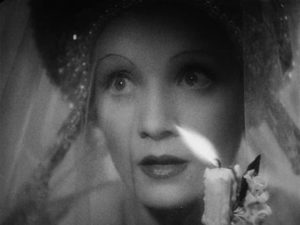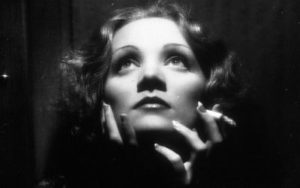STUDIO: Criterion | DIRECTOR: Josef von Sternberg | CAST: Marlene Dietrich, Gary Cooper, Victor McLaglen, Anna May Wong, Cary Grant, Lionel Atwill
RELEASE DATE: 7/3/17 | PRICE: DVD $62.49, Blu-ray $62.49
BONUSES: interviews with film scholars and director Josef von Sternberg’s son, Nicholas; featurettes on Dietrich’s German origins and her status as a feminist icon; a 1936 Lux Radio Theatre adaptation of Morocco; a video essay, the 1935 publicity short “The Fashion Side of Hollywood”; and a 1971 TV interview with Dietrich
SPECS: NR | 542 min. | Drama | 1.37:1 fullscreen | mono
Nicholas von Sternberg, the son of Josef, retells one of the more famous anecdotes about Marlene Dietrich in an interview included in this exemplary six-film collection. The story finds Dietrich on a movie set in the Fifties, lamenting some incompetence by a crew member with the plaintive cry, “Joe, where are you?”
The Joe in question was, of course, Dietrich’s mentor, and the filmmaker who showed her off to best advantage in every shot, Josef von Sternberg. This box set of the half-dozen films they made together in Hollywood after the success in Europe and America of The Blue Angel (1930) features many such stories about Marlene and “Joe,” who without question did their finest work together.
The Dietrich and von Sternberg in Hollywood box includes beautifully restored copies of the films, plus a wealth of extras that contain historical background and surprisingly personal info about its two subjects. The two have been depicted as a “talkie”-era Pygmalion saga; the actual truth is a lot more complex and involves the pricklier aspects of both their personalities.
The most impressive thing about the films is Sternberg’s imaginative creation of “exotic” settings based on real cities. His control of his films extended from the sets (which he personally painted in some instances) and the exquisite lighting (thus the “Joe, where are you?” story) to costumes (Dietrich’s feathers, fur and lace-trimmed outfits) and even the furniture (Sternberg designed the sculpted chairs in Scarlet Empress).
Different viewers will prefer different films in the set, but certain things are indisputable. Blonde Venus (1932) is the most “normal” of the batch, a kind of Stella Dallas-like “anguished mother” drama that is surprisingly unlike the rest of the films, plot-wise. Morocco (1930), Dishonored (1931) and The Shanghai Express (1932) are the most “exotic” dramas, films that helped crystallized Dietrich’s screen persona and reflected Sternberg’s mysterious and beautiful talent for crafting artificial environments.
The last two films, The Scarlet Empress (1934) and The Devil Is a Woman (1935), are the most perfect expressions of Sternberg’s genius. Scarlet is an amazing creation — an historical fantasia with Dietrich as Catherine the Great that prefigures the work of Ken Russell in its desire to mock historical dramas and yet conveys the filmmaker’s fascination with the time period and personas the film depicts. Devil is a breezier affair that Dietrich cited as her favorite film — a femme fatale yarn filled with tongue-in-cheek humor and wondrously ornate detail.
Dietrich’s talents are beautifully showcased in each film. Seeing them in succession brings out the fact that, while Sternberg might have been depicted as her “puppet master,” her own immense talent would’ve surfaced in some context eventually — although not as a wartime performer in Germany, as she loathed Hitler from the first and did everything to fight against him from the time that WWII was declared.
The collection contains onscreen supplements that tackle the films from several different angles. Film scholars Gerd Gemünden and Noah Isenberg reflect on the Weimar era in Germany and the way in which Germans considered Dietrich a “traitor” (even through the 1980s) because of her move to Hollywood and her unwavering support of the Allies during the war.
Film scholar Janet Bergstrom discusses Sternberg’s career in silent film, as well as the fact that the filmmaker and his star were lovers. Bergstrom contends that Sternberg got involved with Dietrich “as early as he could” and remained her lover “for as long as he could,” despite Dietrich’s other affairs and the fact that she was married throughout this entire period.
An audiovisual essay by critics Cristina Álvarez López and Adrian Martin offers a kind of “supercut” of the most striking images from the films, with visual motifs isolated and “commented” on by intertitles with quotes from academics and von Sternberg himself.
The memorable outfits worn by Dietrich in these films are discussed by costume designer Deborah Nadoolman Landis. She pays tribute to Paramount costumer Travis Banton, whom Landis maintains was as responsible for Marlene’s success as Sternberg was.
Appropriately enough, Landis comments on the scandal that was caused by Dietrich’s wearing men’s clothing in Sternberg’s films and how it became an international fashion trend. This one fact is mentioned in three different supplements in this collection — one more time than the historically relevant fact that she was considered a “traitor” by the German public.
Scholar Homay King focuses specifically on Shanghai Express, and its “orientalist” aspect. King puts forth both arguments — that the film has “problems” involving racist characters and factual inaccuracies about China, but that the plot is the least important thing about the film, and that Sternberg employed a significant number of Asian actors for it, even more (King says) than are employed in Hollywood’s “Asian” movies today.
King also explores the life of Shanghai costar Anna May Wong, who had a multicultural trajectory similar to Dietrich’s and who achieved a similar cult following, albeit smaller.
The featurette in which three authors analyze Dietrich’s bisexual image, her gay audience, and the feminist aspects of her image is the most academic entry in the set. Among the polysyllabic phrases used are “heteronormative,” “iconicity,” and “homosociality.”
Coming back down from the rarified climes of academia, the interview with Nicholas von Sternberg referred to above finds him talking about his father’s reputation in Hollywood and his justly famed lighting techniques. The most interesting thing he mentions is his father’s attention to detail, including his time painting his sets (aluminum paint to work with the lighting, but shellac was used for shadows).
Dietrich’s possessions, which are now held by the Deutsche Kinemathek, are the topic of another supplement. Curator Silke Ronneburg notes that the museum has kept all of the items intact, in a collection that takes up 3,000 square feet of space. One fascinating find is a set of publicity photos of Dietrich taken when she arrived in America that are non-glamorous and brightly lit. Sternberg had the photos taken out of circulation, in favor of darker, more evocative (and insanely glamorous) images that he oversaw.
Dietrich was a keeper of many secrets about her personal life, which is apparent in a 1971 TV interview conducted for Swedish television. This talk is riveting to watch, if only because Marlene seems willing to answer the two interviewers’ questions but offers very simplistic and not-very-forthcoming replies.
She steadfastly maintains that she never let anyone “remake” her — her statement about Sternberg overseeing her career in the early Thirties is that he “put me into a certain frame he thought would be successful.”
She also declares that she most enjoyed singing live in England and attempts to diplomatically clarify why she disliked performing in Germany. While maintaining that German audiences are “wonderful,” she says that the German press was very hard on her. In characteristic fashion, she clarifies nothing.
It is noted by Gemunden and Isenberg in their featurette that the Germans public eventually “forgave” Dietrich, and she was buried in Berlin in 1992 with much fanfare. A city square in Berlin was named after her, and her former “treacherous” reputation was buried along with her.
|
Buy or Rent Dietrich and von Sternberg in Hollywood
|
|---|



Leave a Reply